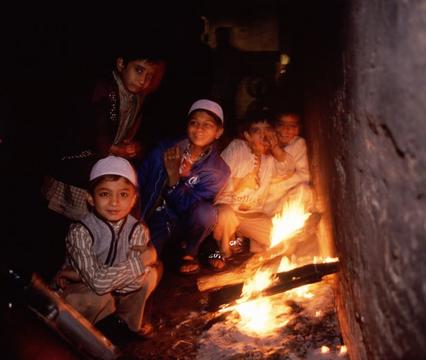 Boys sitting next to a fire in an alley off of a street market in Delhi.
Boys sitting next to a fire in an alley off of a street market in Delhi. |
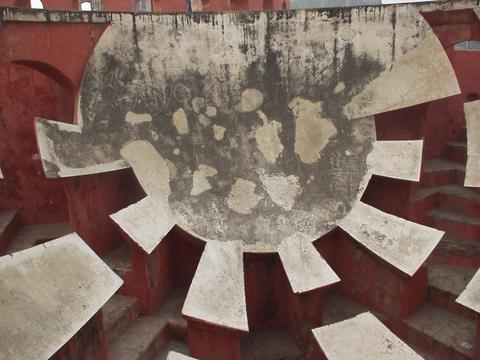 This is one of the many strange looking astronomical devices in the Jantar Mantar Observatory; one of the sundials here was capable of resolving down to the half second. Built by Maharaja Jai Singh in 1725, it is one of five that he built; I later saw the only one still in working order in Jaipur.
This is one of the many strange looking astronomical devices in the Jantar Mantar Observatory; one of the sundials here was capable of resolving down to the half second. Built by Maharaja Jai Singh in 1725, it is one of five that he built; I later saw the only one still in working order in Jaipur. |
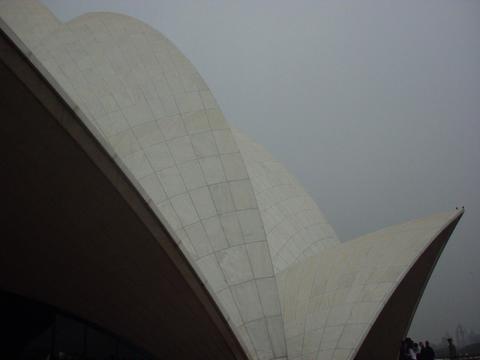 Dramatic from the outside, the Bahai "Lotus" Temple is comparatively simple on the inside. After waiting in a queue to hear a quick speech on how it was necessary to be quiet, I was let in with a few other people. I sat and enjoyed the (relative) silence; I counted only fifteen other people who were actually sitting quietly inside, although my best guess was that there were at least two thousand people visible immediately outside.
Dramatic from the outside, the Bahai "Lotus" Temple is comparatively simple on the inside. After waiting in a queue to hear a quick speech on how it was necessary to be quiet, I was let in with a few other people. I sat and enjoyed the (relative) silence; I counted only fifteen other people who were actually sitting quietly inside, although my best guess was that there were at least two thousand people visible immediately outside. |
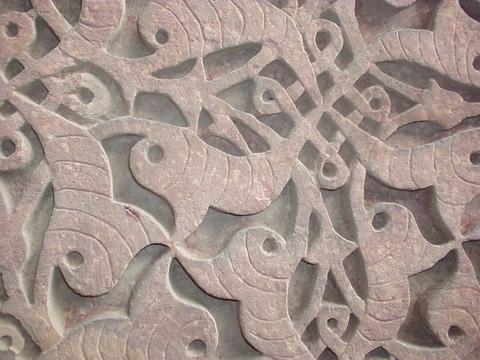 The Quwwat-ul-Islam Masjid ("Masjid" means "mosque") was built next to the Qutb Minar, and a sign in front of it stated that it was built with materials from 27 Jain and Hindu temples that had been destroyed.
The Quwwat-ul-Islam Masjid ("Masjid" means "mosque") was built next to the Qutb Minar, and a sign in front of it stated that it was built with materials from 27 Jain and Hindu temples that had been destroyed. |
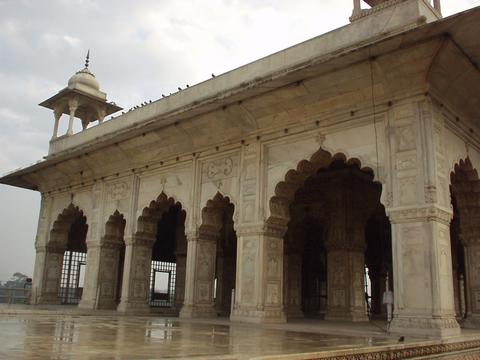 There are a certain set of structures that you just have to have in order to have a complete Moghul fort, and a Diwan-i-Khas (hall of private audience) and a Diwan-i-Am (hall of public audience) top the list. This is the Diwan-i-Khas of the Red Fort.
There are a certain set of structures that you just have to have in order to have a complete Moghul fort, and a Diwan-i-Khas (hall of private audience) and a Diwan-i-Am (hall of public audience) top the list. This is the Diwan-i-Khas of the Red Fort. |
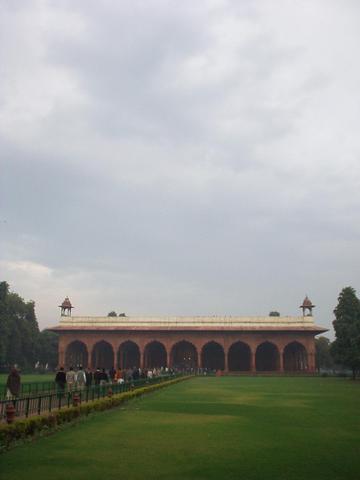 The Diwan-i-Am of the Red Fort.
The Diwan-i-Am of the Red Fort. |
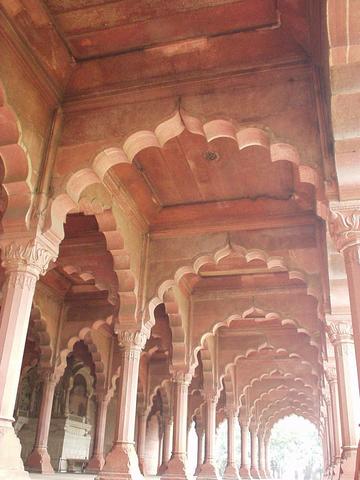 The Diwan-i-Am of the Red Fort, up close and personal.
The Diwan-i-Am of the Red Fort, up close and personal. |
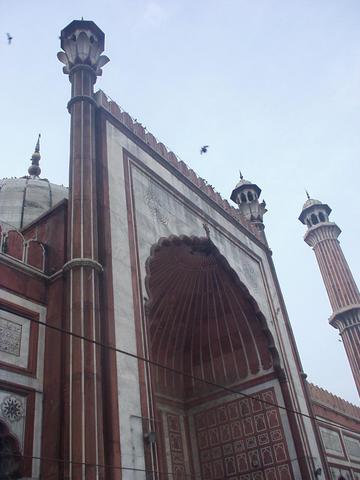 Built by Shah Jehan, the Mughal emperor with the greatest propensity for building (the Taj Mahal, Agra Fort, and Red Fort were all built under his aegis), the Jama Masjid is built in the white marble/red sandstone motif common to all four structures.
Built by Shah Jehan, the Mughal emperor with the greatest propensity for building (the Taj Mahal, Agra Fort, and Red Fort were all built under his aegis), the Jama Masjid is built in the white marble/red sandstone motif common to all four structures. |
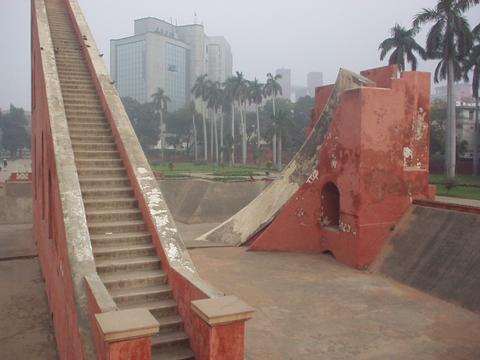 The staircase of the largest sundial of the Jantar Mantar.
The staircase of the largest sundial of the Jantar Mantar. |
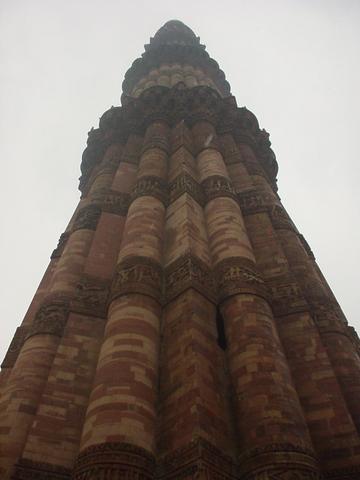 The Qutb Minar was started in 1193 by Qutb-ud-din to commemorate the defeat of the last Hindu kindom near Delhi, and the arrival of Islam in the subcontinent.
The Qutb Minar was started in 1193 by Qutb-ud-din to commemorate the defeat of the last Hindu kindom near Delhi, and the arrival of Islam in the subcontinent. |
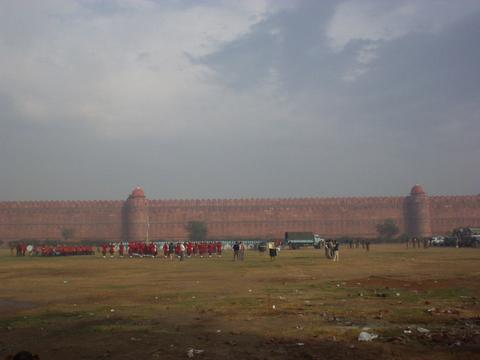 On my way to the Red Fort, I stopped and listened for at least half an hour to several police and military drum-and-bagpipe bands, which really made me long for a pint of stout. This could have benefitted from walking closer (or a longer lens), obviously, but there were men with guns keeping spectators at bay.
On my way to the Red Fort, I stopped and listened for at least half an hour to several police and military drum-and-bagpipe bands, which really made me long for a pint of stout. This could have benefitted from walking closer (or a longer lens), obviously, but there were men with guns keeping spectators at bay. |
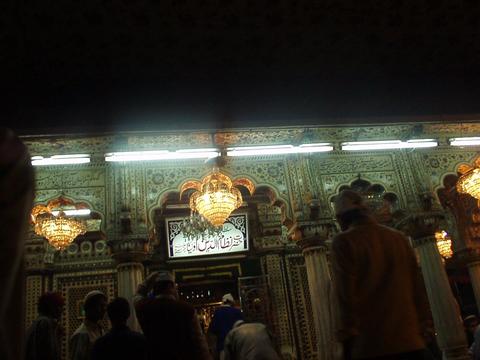 In William Dalrymple's City of Djinns: A Year in Delhi (which, using the duration mentioned in the title, involved inhaling 29,200 cigarettes worth of pollution, according to a WHO study) he describes a visit to the shrine of Nizam-ud-din, a Sufi mystic who still commands a large following 600 years after his death, where every Thursday there is a Qawwali concert to praise him. It was amazing. It was not possible to take a picture of the performers, but this is the shrine.
In William Dalrymple's City of Djinns: A Year in Delhi (which, using the duration mentioned in the title, involved inhaling 29,200 cigarettes worth of pollution, according to a WHO study) he describes a visit to the shrine of Nizam-ud-din, a Sufi mystic who still commands a large following 600 years after his death, where every Thursday there is a Qawwali concert to praise him. It was amazing. It was not possible to take a picture of the performers, but this is the shrine. |
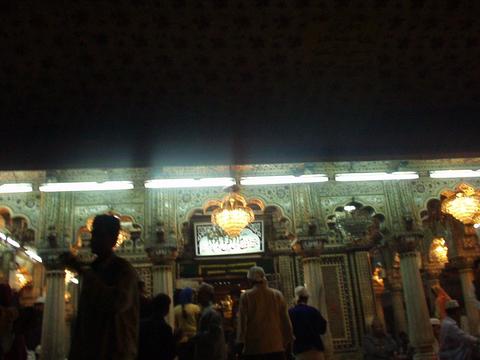
|
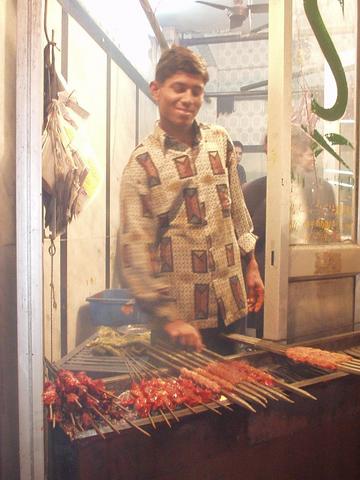 Muslim boy preparing sheek kebabs in the winding alleys near Nizam-ud-din's shrine, Delhi.
Muslim boy preparing sheek kebabs in the winding alleys near Nizam-ud-din's shrine, Delhi. |
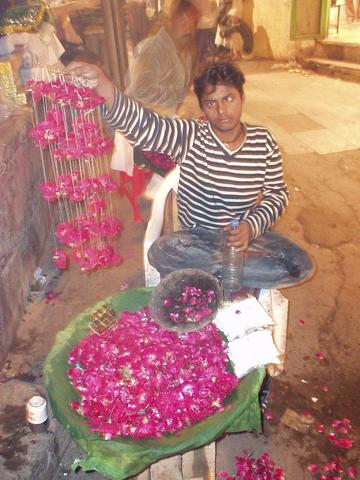 Boy selling rose petals for those asking for Nizam-ud-din's favor, which they then toss on his grave in the interior of the shrine.
Boy selling rose petals for those asking for Nizam-ud-din's favor, which they then toss on his grave in the interior of the shrine. |
 Boys sitting next to a fire in an alley off of a street market in Delhi.
Boys sitting next to a fire in an alley off of a street market in Delhi. This is one of the many strange looking astronomical devices in the Jantar Mantar Observatory; one of the sundials here was capable of resolving down to the half second. Built by Maharaja Jai Singh in 1725, it is one of five that he built; I later saw the only one still in working order in Jaipur.
This is one of the many strange looking astronomical devices in the Jantar Mantar Observatory; one of the sundials here was capable of resolving down to the half second. Built by Maharaja Jai Singh in 1725, it is one of five that he built; I later saw the only one still in working order in Jaipur. Dramatic from the outside, the Bahai "Lotus" Temple is comparatively simple on the inside. After waiting in a queue to hear a quick speech on how it was necessary to be quiet, I was let in with a few other people. I sat and enjoyed the (relative) silence; I counted only fifteen other people who were actually sitting quietly inside, although my best guess was that there were at least two thousand people visible immediately outside.
Dramatic from the outside, the Bahai "Lotus" Temple is comparatively simple on the inside. After waiting in a queue to hear a quick speech on how it was necessary to be quiet, I was let in with a few other people. I sat and enjoyed the (relative) silence; I counted only fifteen other people who were actually sitting quietly inside, although my best guess was that there were at least two thousand people visible immediately outside. The Quwwat-ul-Islam Masjid ("Masjid" means "mosque") was built next to the Qutb Minar, and a sign in front of it stated that it was built with materials from 27 Jain and Hindu temples that had been destroyed.
The Quwwat-ul-Islam Masjid ("Masjid" means "mosque") was built next to the Qutb Minar, and a sign in front of it stated that it was built with materials from 27 Jain and Hindu temples that had been destroyed. There are a certain set of structures that you just have to have in order to have a complete Moghul fort, and a Diwan-i-Khas (hall of private audience) and a Diwan-i-Am (hall of public audience) top the list. This is the Diwan-i-Khas of the Red Fort.
There are a certain set of structures that you just have to have in order to have a complete Moghul fort, and a Diwan-i-Khas (hall of private audience) and a Diwan-i-Am (hall of public audience) top the list. This is the Diwan-i-Khas of the Red Fort. The Diwan-i-Am of the Red Fort.
The Diwan-i-Am of the Red Fort. The Diwan-i-Am of the Red Fort, up close and personal.
The Diwan-i-Am of the Red Fort, up close and personal. Built by Shah Jehan, the Mughal emperor with the greatest propensity for building (the Taj Mahal, Agra Fort, and Red Fort were all built under his aegis), the Jama Masjid is built in the white marble/red sandstone motif common to all four structures.
Built by Shah Jehan, the Mughal emperor with the greatest propensity for building (the Taj Mahal, Agra Fort, and Red Fort were all built under his aegis), the Jama Masjid is built in the white marble/red sandstone motif common to all four structures. The staircase of the largest sundial of the Jantar Mantar.
The staircase of the largest sundial of the Jantar Mantar. The Qutb Minar was started in 1193 by Qutb-ud-din to commemorate the defeat of the last Hindu kindom near Delhi, and the arrival of Islam in the subcontinent.
The Qutb Minar was started in 1193 by Qutb-ud-din to commemorate the defeat of the last Hindu kindom near Delhi, and the arrival of Islam in the subcontinent. On my way to the Red Fort, I stopped and listened for at least half an hour to several police and military drum-and-bagpipe bands, which really made me long for a pint of stout. This could have benefitted from walking closer (or a longer lens), obviously, but there were men with guns keeping spectators at bay.
On my way to the Red Fort, I stopped and listened for at least half an hour to several police and military drum-and-bagpipe bands, which really made me long for a pint of stout. This could have benefitted from walking closer (or a longer lens), obviously, but there were men with guns keeping spectators at bay. In William Dalrymple's City of Djinns: A Year in Delhi (which, using the duration mentioned in the title, involved inhaling 29,200 cigarettes worth of pollution, according to a WHO study) he describes a visit to the shrine of Nizam-ud-din, a Sufi mystic who still commands a large following 600 years after his death, where every Thursday there is a Qawwali concert to praise him. It was amazing. It was not possible to take a picture of the performers, but this is the shrine.
In William Dalrymple's City of Djinns: A Year in Delhi (which, using the duration mentioned in the title, involved inhaling 29,200 cigarettes worth of pollution, according to a WHO study) he describes a visit to the shrine of Nizam-ud-din, a Sufi mystic who still commands a large following 600 years after his death, where every Thursday there is a Qawwali concert to praise him. It was amazing. It was not possible to take a picture of the performers, but this is the shrine.
 Muslim boy preparing sheek kebabs in the winding alleys near Nizam-ud-din's shrine, Delhi.
Muslim boy preparing sheek kebabs in the winding alleys near Nizam-ud-din's shrine, Delhi. Boy selling rose petals for those asking for Nizam-ud-din's favor, which they then toss on his grave in the interior of the shrine.
Boy selling rose petals for those asking for Nizam-ud-din's favor, which they then toss on his grave in the interior of the shrine.